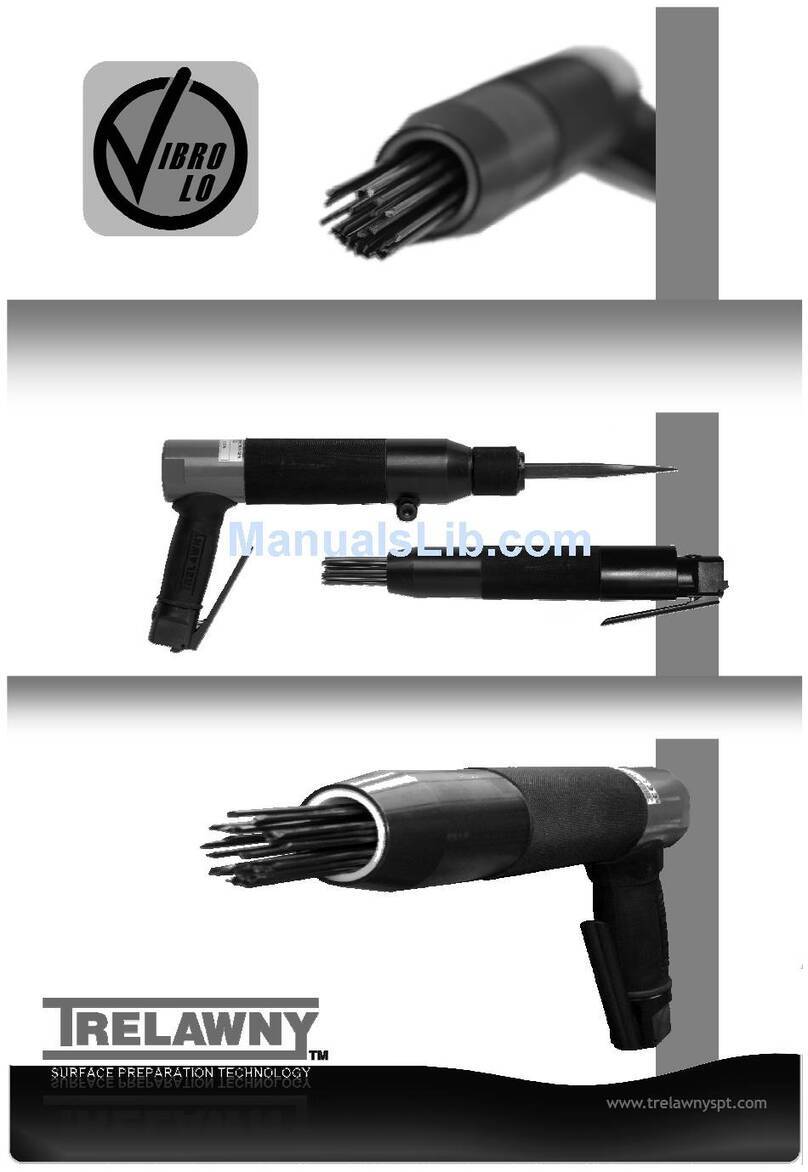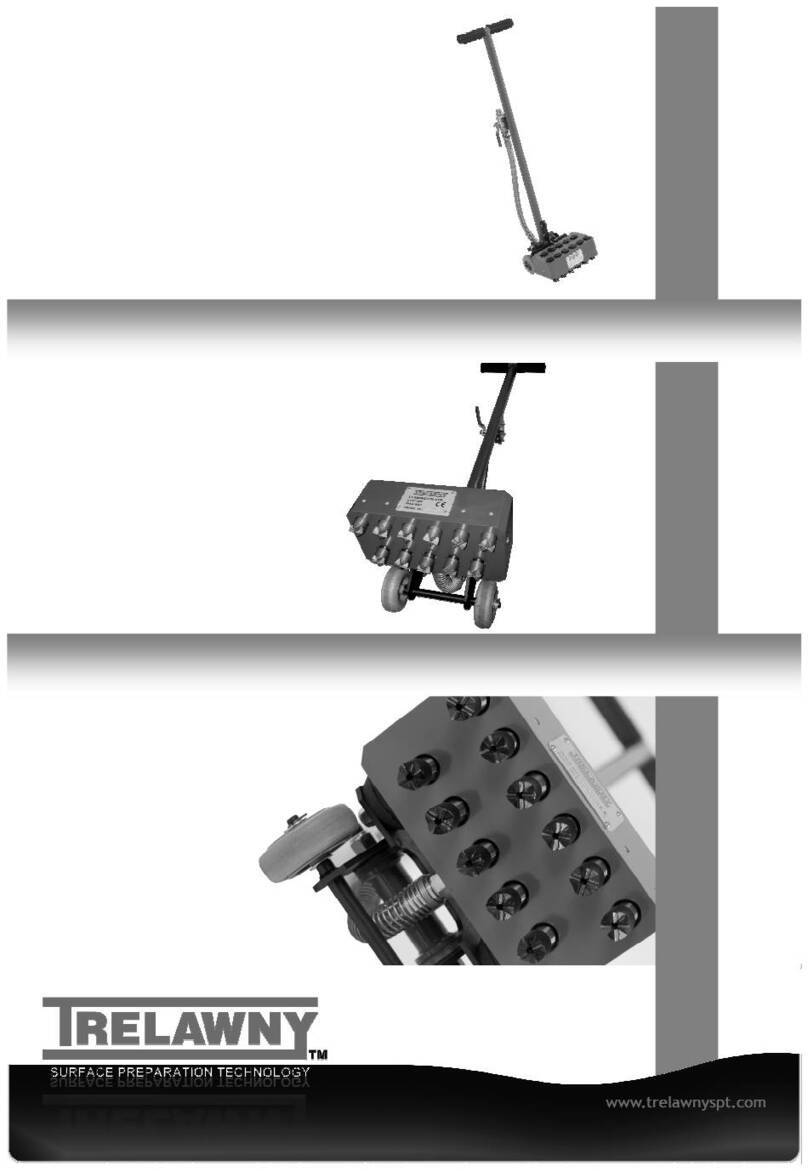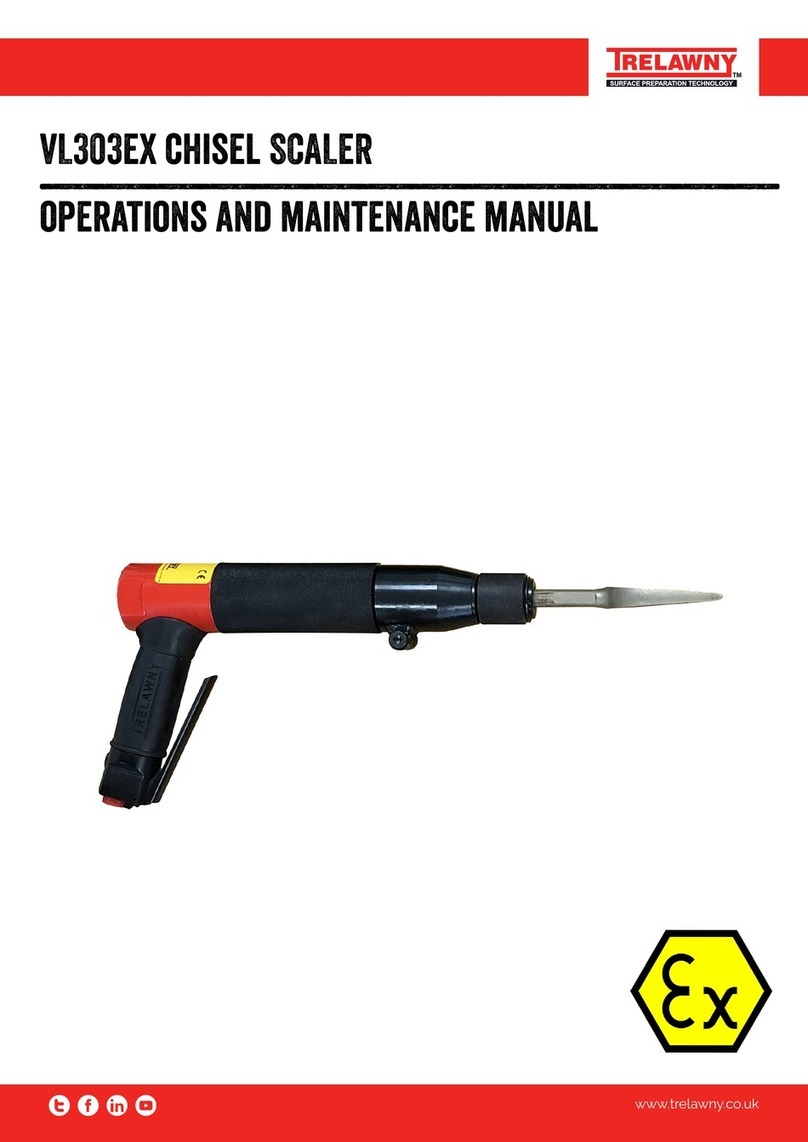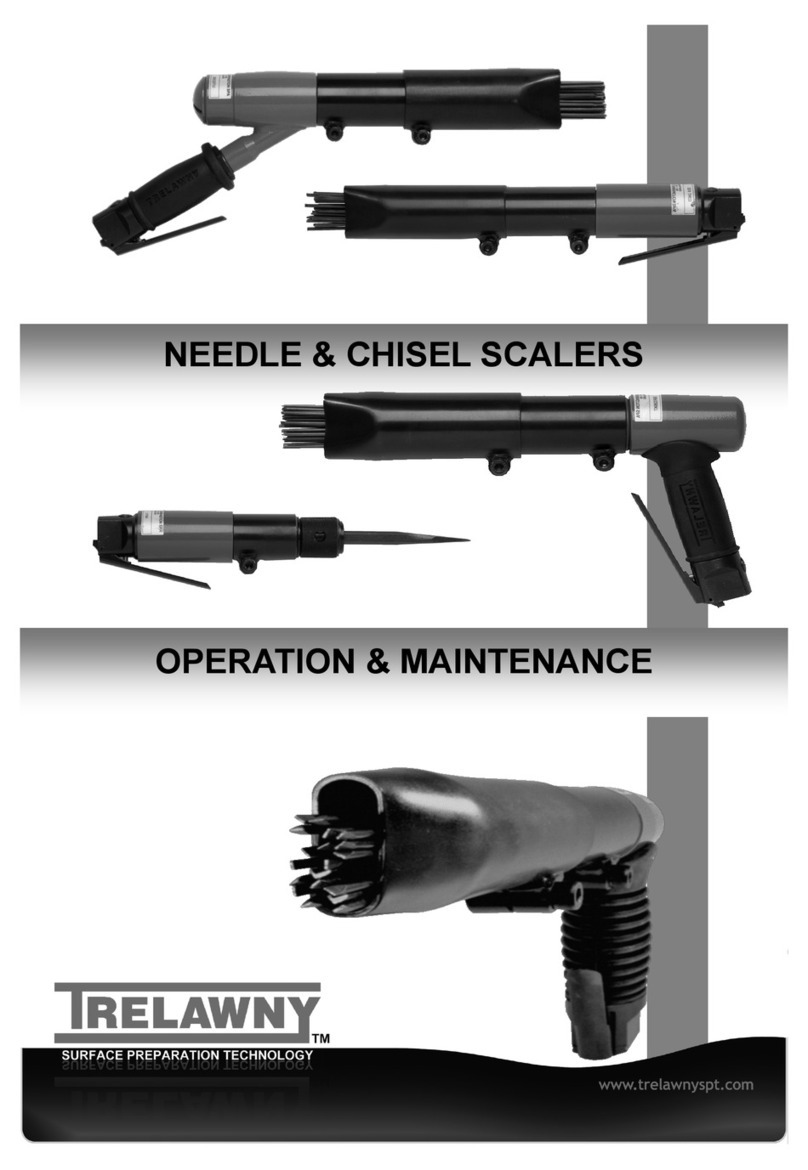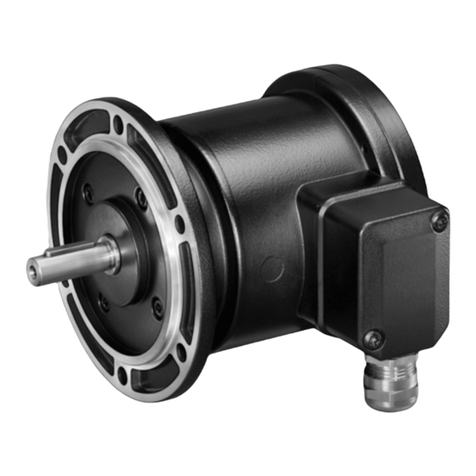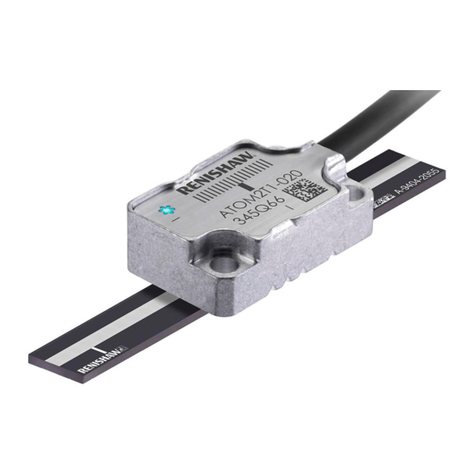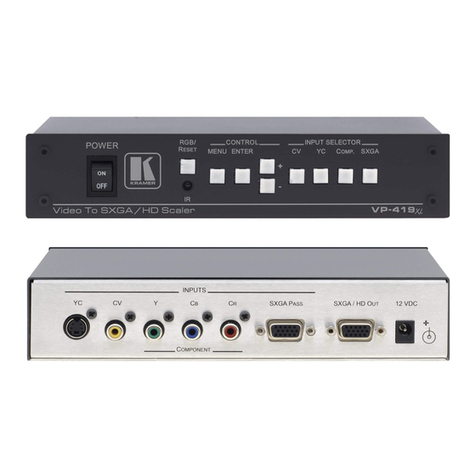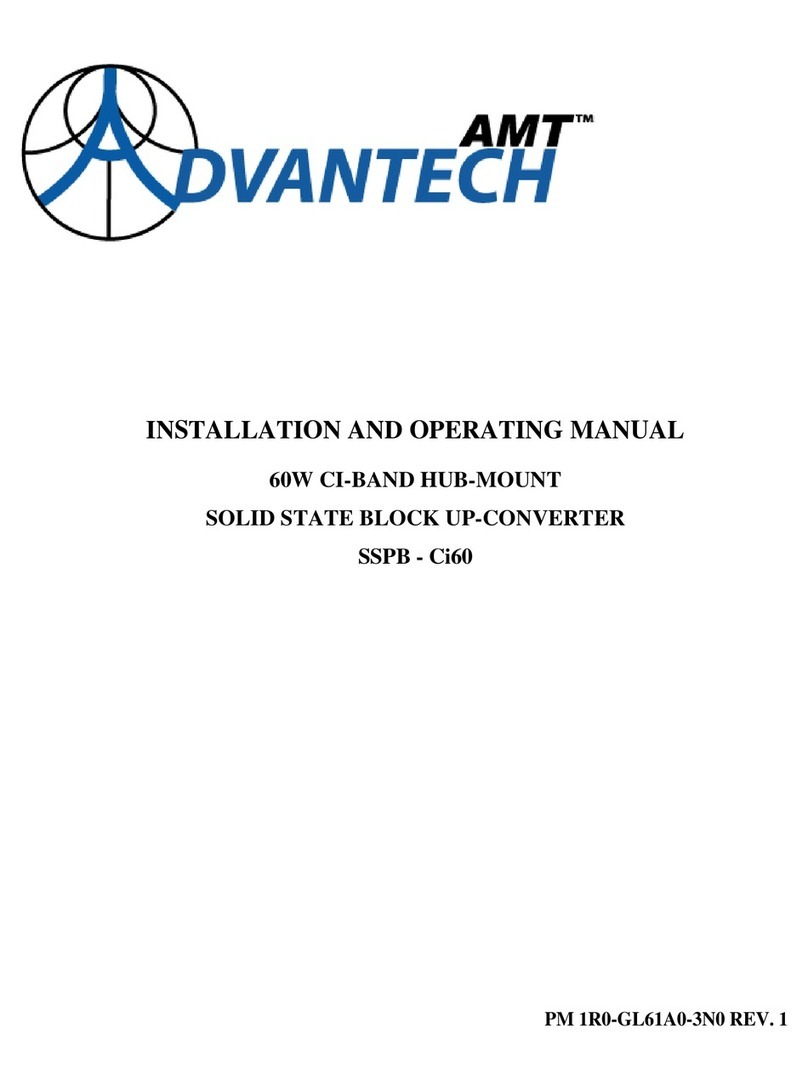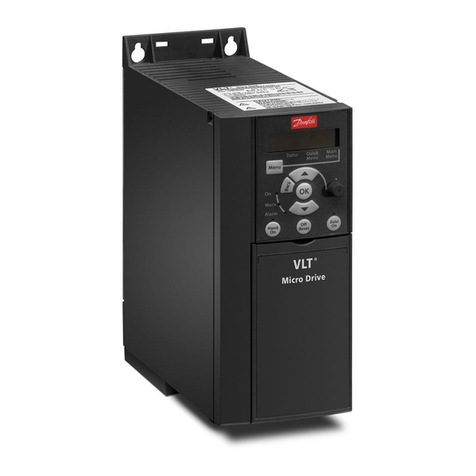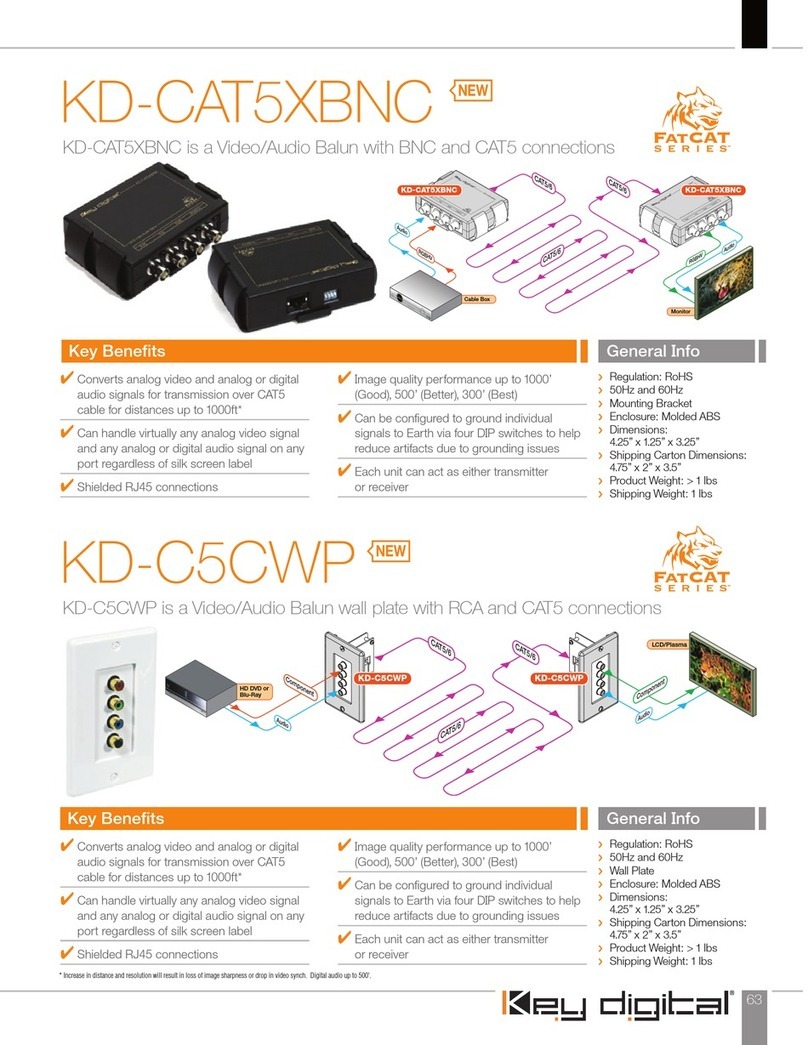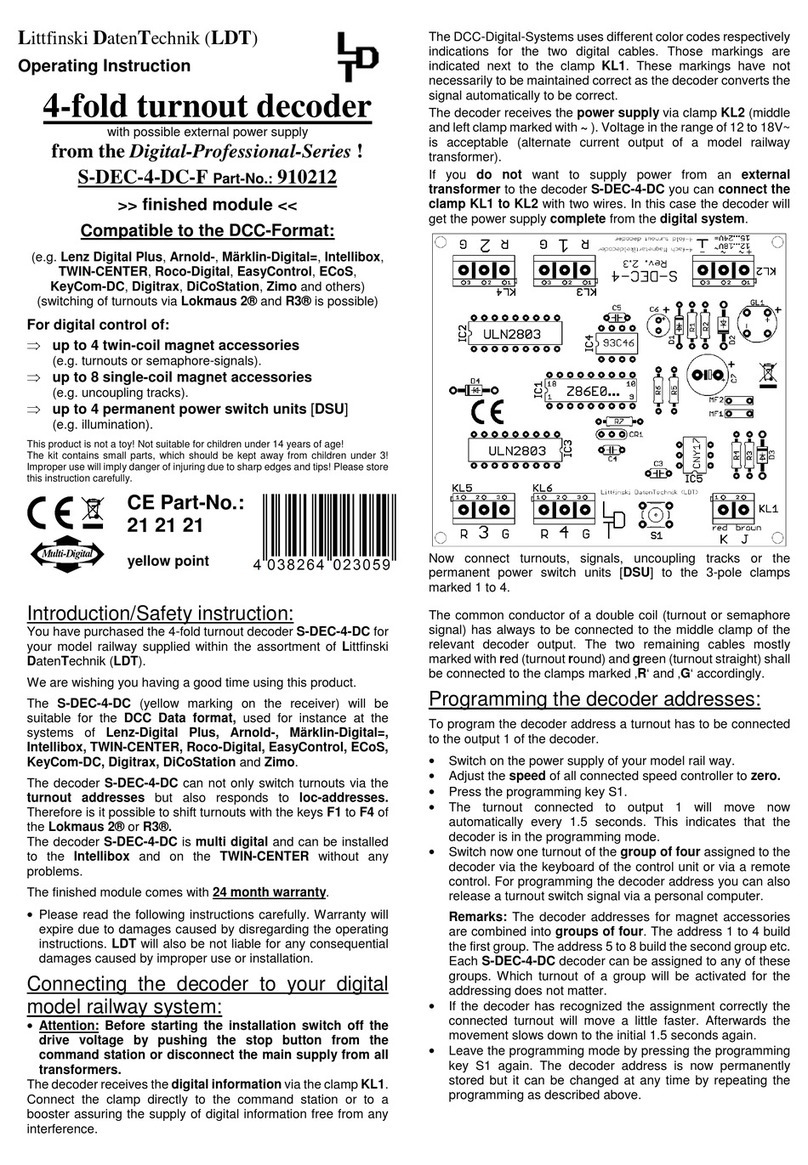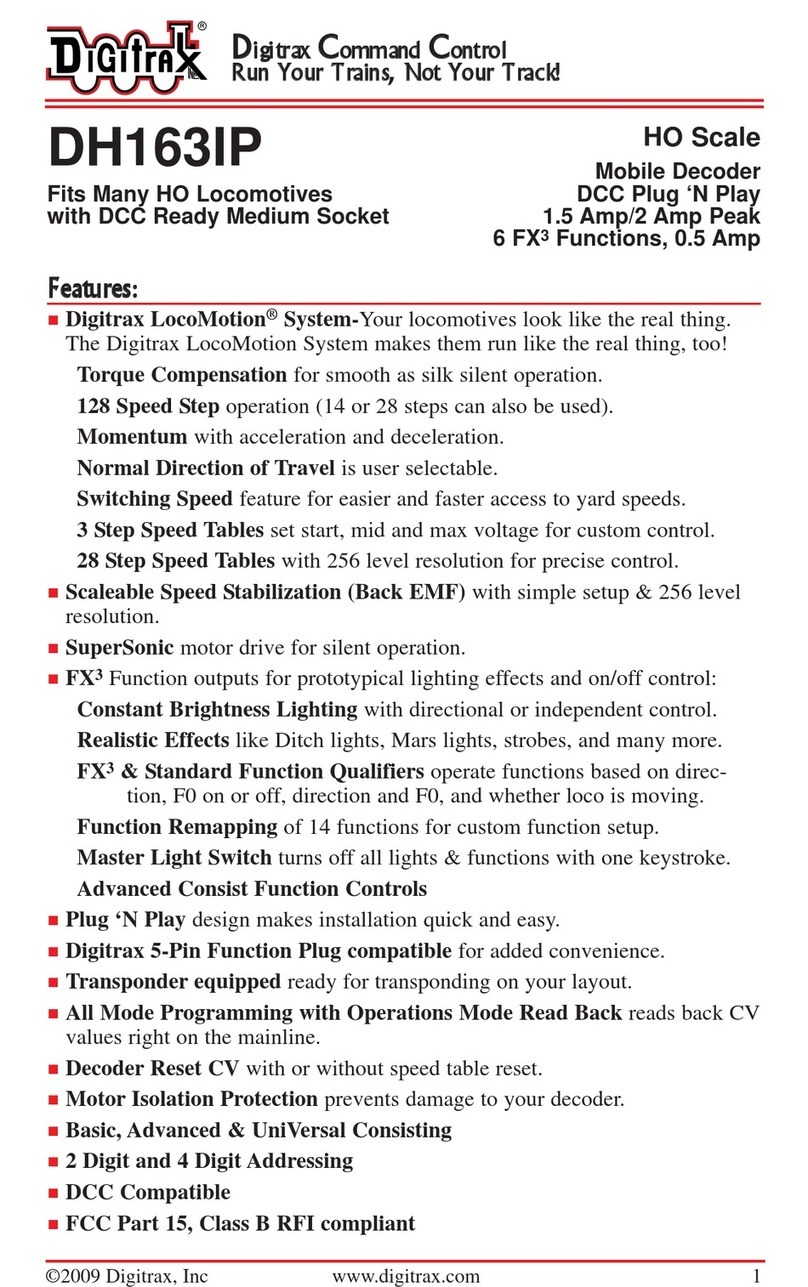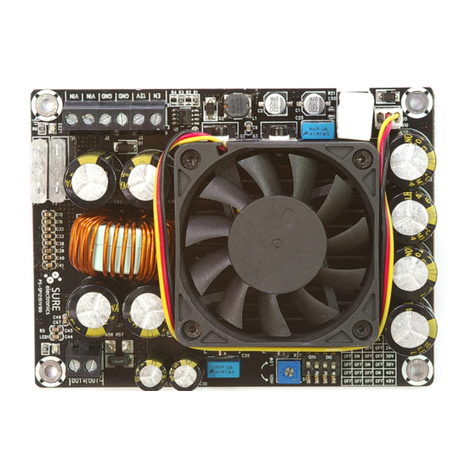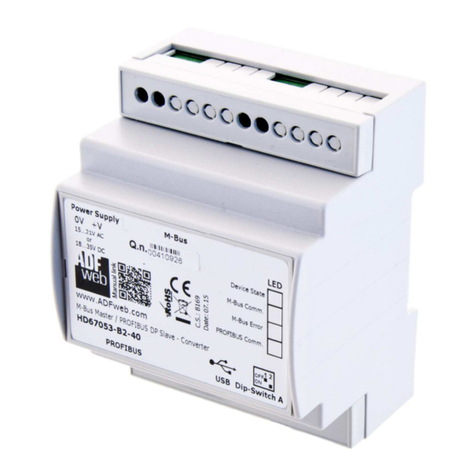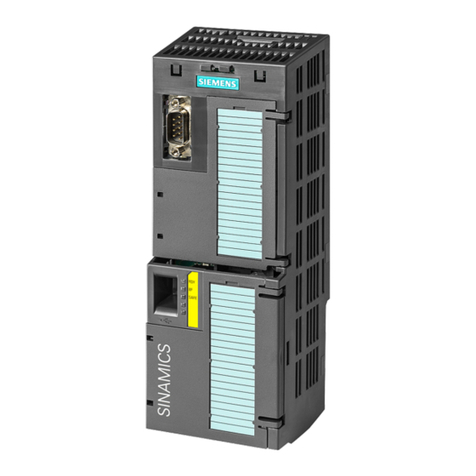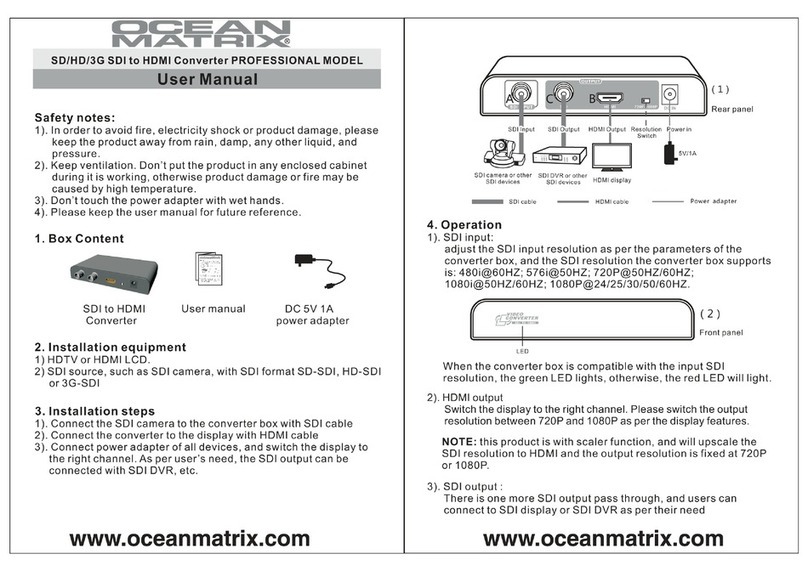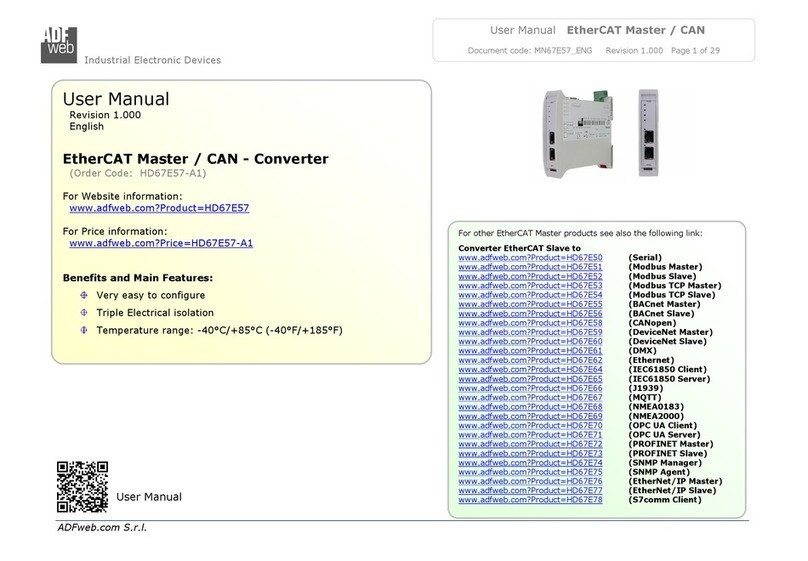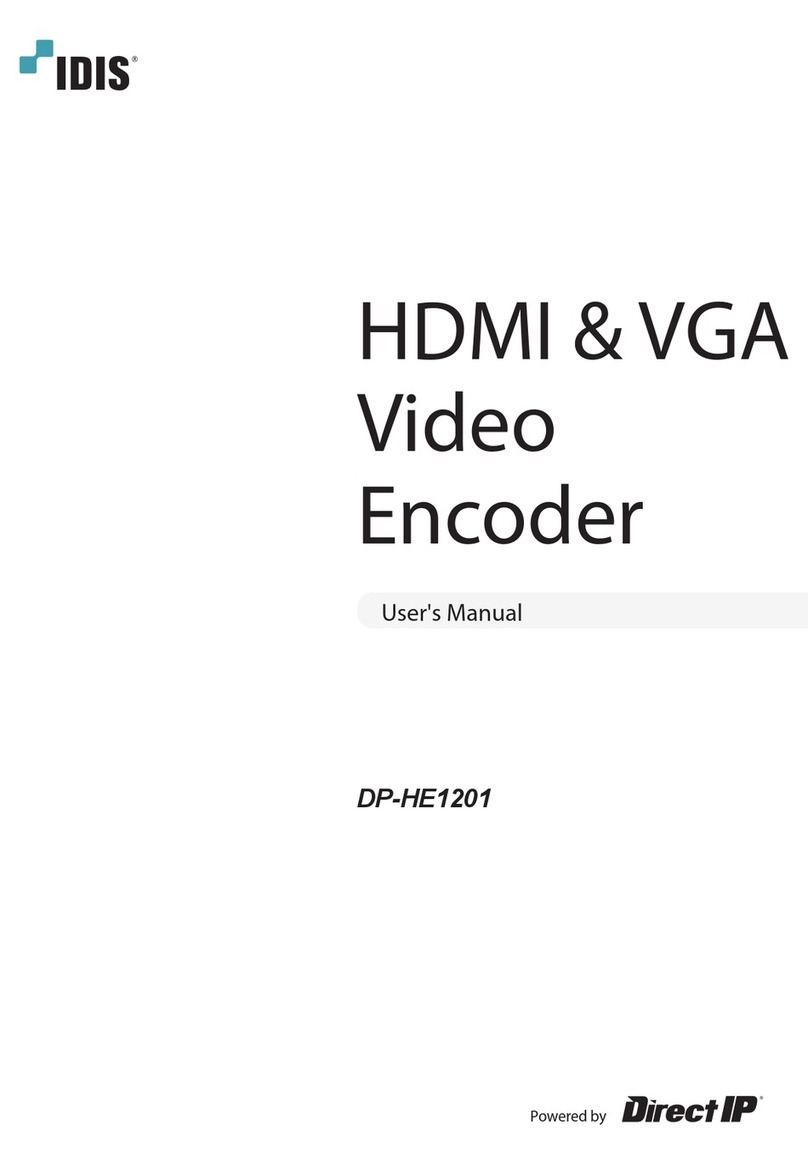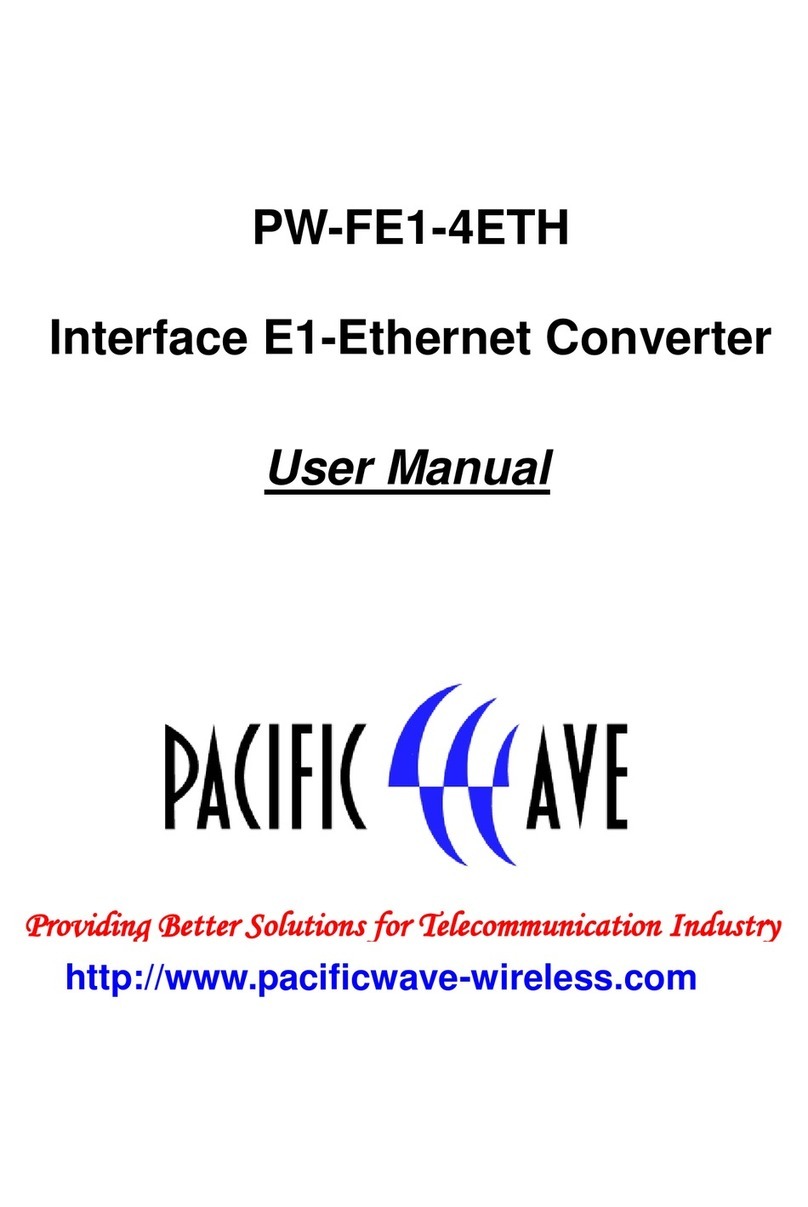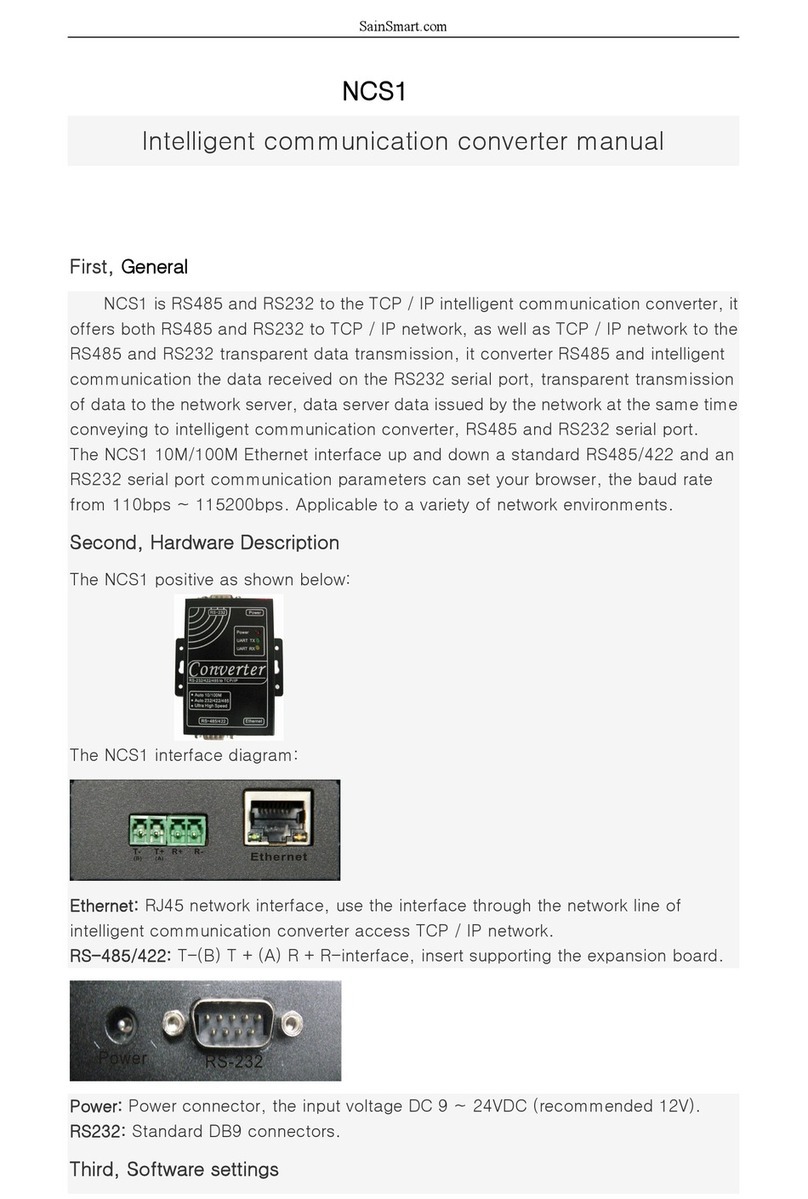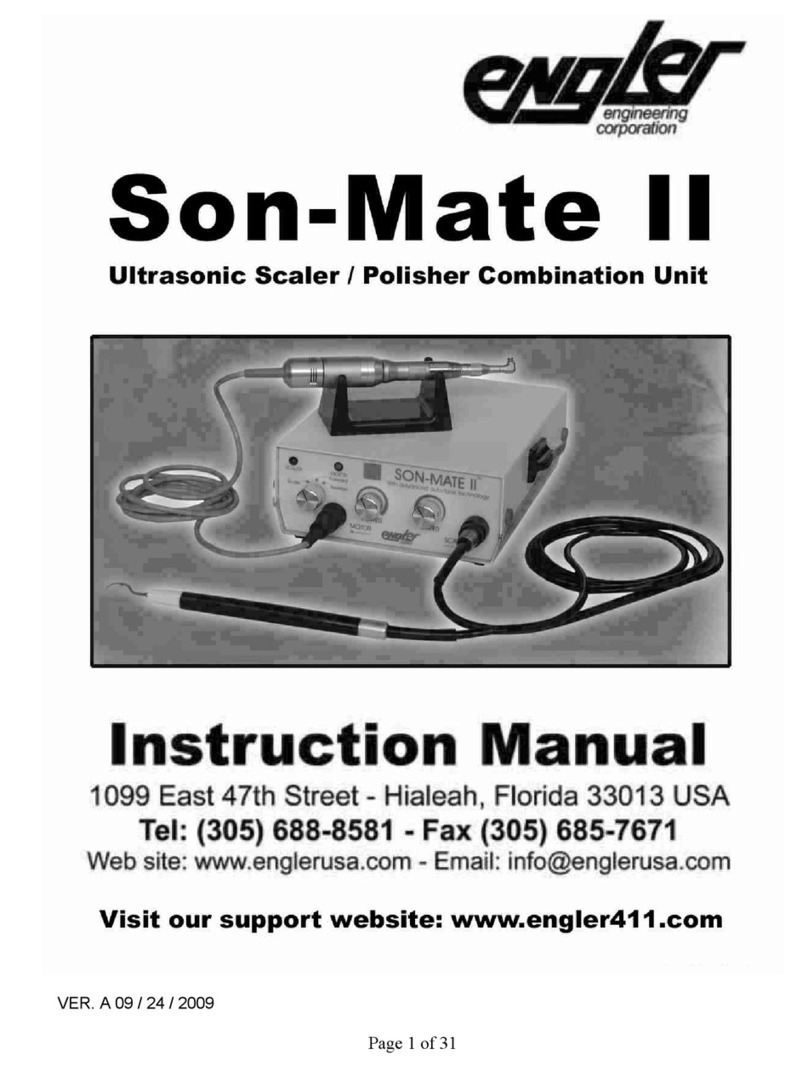Trelawny LR2 User manual

Long Reach Scalers
Operation and Maintenance Manual
www.trelawnyspt.co.uk



OPERATION
General Information
Before operating, performing maintenance or
repairing the Long Reach Scaler this manual
must be read and understood by the operator,
if in any doubt, ask your supervisor before
using this equipment.
Local safety regulations must be followed at
all times. Failure to follow these instructions
could result in damage to the Scaler and/or
personal injury.
Trelawny SPT Limited disclaims all
responsibility for damage to persons or
objects arising as a consequence of incorrect
handling of the tool, failure to inspect the tool
for damage or other faults that may influence
the operation prior to starting work, or failure
to follow the safety regulations listed or
applicable to the job site.
The tool is primarily designed for the removal
of workshop soiling, solidified paint spills,
carpet and ceramic tile removal, heavy rust,
and scale, concrete splashes and ; it can also
be used for the removal of laitance from
concrete.
This tool must not be used in a fixture.
This tool can be purchased in either Needle
Scaler or Chisel Scaler versions, with an
adaptor available for converting from one
version to another. It can be used both
indoors and out.
Air Supply
The compressed air must be free from water
and dirt. The installation of a filter/regulator/
lubricator air preparation set (with moisture
trap) adjacent to the tool is strongly
recommended.
Always clear the air hose before connecting to
the tool. Ensure that no moisture
(condensation) is present in the air hose.
Ensure that a minimum 10mm (3/8”) bore air
hose is used and that all couplings are
secure, leak free and in good condition.
Limit the length of air hose to 10M (33ft).
Where extra length is necessary, for each
additional 15M (50ft) of air hose used, the
pressure drop is approximately 0.21bar
(3psi).
For safe and efficient operation the correct
operating pressure is 6.2bar (90 psi).
Do not let the operating pressure fall below
5.5bar (80p.s.i.) or rise above 6.9bar (100 psi)
absolute maximum.
Preferably, the compressor should be able to
supply a minimum of 2.8 L/s (6 cfm).
In particularly cold temperatures it is
recommended that a proprietary anti-freeze
lubricating oil is used.
Lubrication
Oil the tool daily before use. Put a few drops
of one of the following zinc free air tool
lubricants through the air inlet.
SHELL S22 or R10
CASTROL Hyspin ZZ32
See also the section on AIR SUPPLY for
further information and recommendations.
Safety
Always, read through these instructions first
before use.
Do-
Be aware that this tool is not electrically
insulated.
Wear Personal Protective Equipment
including safety goggles, footwear, ear
defenders and gloves. In some environments
it will be necessary to wear
facemasks or breathing apparatus.
Be aware that this tool can create dust and
flying debris.
Keep hands and clothing away from moving
parts.
Store this tool in a secure and dry
environment.
Be aware of others working around you.
Ensure that this tool is lubricated daily.
Always observe safe-working practices at
all times.
Do not-
Allow the tool to run unattended.
Modify this tool in any way, as this will
invalidate the warranty and could lead to
serious injury.
Allow the tool to run continuously whilst not in
contact with the surface being prepared.
Use the tool if you become tired, this can lead
to physical strain or injuries.
Hold the exposed chisel or needles whilst the
tool is in use, this could cause vibration
damage to the hands.
Use this tool in potentially explosive
environments.
Drag this tool by the air hose.
Use petrol (gasoline), thinners or any other
high flash point solvent to clean the tool.
Care must be taken to avoid damaging or
tripping over the trailing air hose.
Please note: Unrestrained hoses can whip
dangerously if they become detached.
Risk of Hand-arm
Vibration injury
These tools may cause Hand-arm Vibration
Syndrome injury if their use is not adequately
managed.
We advise you to carry out a risk assessment
and to implement measures such as:
Limiting exposure time [i.e. actual trigger time,
not total time at work], job rotation, ensuring
the tools are used correctly, ensuring the tools
are m aintained according to our
recommendations, and ensuring that the
operators wear personal protective equipment
[PPE] particularly gloves and clothing to keep
them warm and dry.
Employers should consider setting up a
programme of health surveillance to establish
a benchmark for each operator and to detect
early symptoms of vibration injury.
We are not aware of any PPE that provides
protection against vibration injury by
attenuating vibration emissions.
See ‘Specifications’ section for vibration
emission data.
Further advice is available from our Technical
Department.
We strongly advise you to visit the Health &
S a fe t y E x ec u ti v e w e b si t e h t t p: / /
www.hse.gov.uk/vibration This site provides
excellent advice and information on HAV and
it includes a Hand-arm Vibration Exposure
Calculator that is easy to use to work out the
daily vibration exposure for each of your
operators.
Starting work
Please note:
The carbon steel chisels or needles provided
with these tools are not intended for use in a
potentially explosive atmosphere.
Prior to operating the tool check: -
That all fittings are secure, free from leaks
and air hoses are in good condition.
That the air pressure is correct for this tool
6.2 bar (90 p.s.i.).
Put a few drops of a recommended lubricant
into the air inlet of the tool.
To operate the tool, which is dependant on
the type of lever fitted, for those fitted with a
safety lever, first push thumb button forwards
and then for both styles of lever, pull the lever
towards the hand grip to start the tool, then
apply the Chisel or Needles to the surface
being prepared.
Note: Several types of Chisel are available for
the Long Reach Chisel Scaler to suit the job in
hand, including Aluminium Bronze spark
resistant Chisels; a Needle Scaler Attachment
is also available.
See parts list for details.
Warning! This tool will continue to run for a
few seconds after releasing the throttle lever;
it is recommended that the tool remains in
contact with the work surface until the air is
exhausted. Gloves and personal protective
equipment must be worn when using this tool.
(See previous section on Risk of Vibration
Injury). Care must be taken to avoid damaging
or tripping over the air hose. Maintain contact
with the work surface with sufficient pressure
to keep the tool from bouncing off the surface.
Handled correctly the Long Reach Scaler will
work quickly and efficiently.
To switch off, simply release the throttle
lever.
Safe use of this tool requires a solid stance
and secure foothold, the tool may be used in
other postures but care must be taken to
ensure the operator adopts a firm and stable
position. Excessive operator pressure will not
improve the tools efficiency but could cause
premature tool failure and increase operator
fatigue. It could also increase the vibration
emission level.
Never allow the tool to run continuously
whilst not in contact with the surface being
prepared.
Do not use the Scaler as a lever, if the Chisel
becomes embedded in the material, withdraw
and try again. Never allow the tool to run
continuously whilst not in contact with the
surface being prepared.

MAINTENANCE
Chisels
Various sizes and types of Chisel are
available.
See parts list for details.
Fitting of Chisel Holder
Before fitting the Chisel Holder (31),
disconnect the tool from the air supply.
To fit the Chisel Holder (31) ensure that the
pinch bolt (30) on the Chisel Holder is loose,
screw the Chisel Holder fully on to the
Cylinder (10).
Turn the knurled collar on the Chisel Holder
(31) until the retaining ball is fully visible.
Insert the Chisel (32) into the Chisel Holder
(31) and select the nearest position to align
the blade with the Throttle Lever (7).
Turn the collar half a turn to lock the Chisel
(32) in place.
If the Chisel (32) does not line up, it may
require the Chisel Holder (31) to be
unscrewed slightly.
Tighten the pinch bolt (30) using a 6mm AF
Allen key. To release the Chisel (32), rotate
the knurled collar until the retaining ball is fully
visible and remove the Chisel (32).
Needle Holder Attachment
Before fitting the Needle Scaler Attachment,
disconnect the air supply to the tool.
Assemble the component parts of the Needle
Scaler attachment in the following order;
insert the Needles (26) into the Needle Holder
(25), place the Spring (27) over the Needles,
Pointed tip needles
Sharpened to a nail point, these are most
effective in breaking through very hard scale
on surfaces where some surface indentation
is permissible - or where keying (i.e. profile) of
the surface is desirable.
Pointed tip needles are available in 3mm and
4mm only.
Chisel tip needles
These are general purpose needles, flattened
to a chisel like blade and are most effective in
the removal of thicker material, while leaving a
less pitted surface than the Pointed tip
needles but still giving some surface
indentation (i.e. profile).
Chisel tip needles are available in 3mm only.
Flat tip needles
Machined to a flat tip, these needles will leave
slight marking (i.e. profile) on the surface; the
2mm needles can have a burnishing effect.
2mm Needles are recommended for use on
thin gauge metals and any surface where light
treatment is desired.
Flat tip needles are available in three sizes -
2mm, 3mm and 4mm.
Maintenance
Only a competent person, in a suitably
equipped workshop, must carry out
maintenance.
Disconnect the tool from the air supply
before carrying out any maintenance or
any of the operations in the next sections.
Clean all debris from the exterior of the tool.
Cleaning
At intervals of no more than 40 hours or if
operation becomes unproductive and the
Piston shows signs of sticking, dismantle and
clean with a highly refined paraffin.
Replace worn components as necessary.
Immediately after cleaning, thoroughly oil the
tool with one of the recommended lubricants.
Piston and Cylinder Removal
Remove the Chisel Holder (31) or Needle
Attachment as previously described. Clamp
the Cylinder (10) firmly in a vice using the flats
provided. Using a suitable wrench and the
spanner flats provided, unscrew the Cover
(14) from the Cylinder (10). This may initially
need some extra effort to break the bond.
With the Cylinder (10) free of the Cover, push
the Piston (9) out of the Cylinder (10).
Remove the Cylinder (10) from the vice and
inspect all parts for wear, particularly the
Piston (9) and the Cylinder’s bores. Remove
the two O’ Rings (11)(12) from the Cylinder
(10).
Valve Body Servicing
Clamp the Valve Body Assembly firmly in a
vice at the Valve Body (6) using the flats
provided, with the Throttle Lever (7)
uppermost. Using a 3mm diameter pin punch
and small hammer, remove the Throttle Lever
Roll Pin (8), and remove the Throttle Lever
(7). Rotate the Valve Body (6) 180 degrees in
the vice to gain access the Valve Cap (1).
Unscrew the Valve Cap (1) using a
screwdriver, check the Valve Cap 'O' Ring (2)
for signs of deterioration, remove the Spring
(3), push out the Valve Stem (4) and remove
the valve seat 'O' Ring (5). Check the Valve
Stem (4) and 'O' Ring (5) for wear.
Assembly
Before any assembly takes place, ensure all
parts are clean and are coated in a thin film of
recommended air tool lubricant.
It is strongly recommended that all the
O’Rings and any other worn parts be replaced
using only genuine Trelawny spares.
Valve Body Assembly
Clamp the Valve Body firmly in a vice, using
the flats provided, and with the threaded hole
uppermost.
Insert the valve seat 'O' Ring (5) into Valve
Body (6), followed by the Valve Stem (4),
Spring (3), then the Valve Cap (1) complete
with its 'O' Ring (2), tighten the Valve Cap (1)
with a screwdriver.
Rotate assembly 180 degrees in the vice.
Using a 3mm diameter pin punch locate and
align the Throttle Lever (7) in position, then
drive in the Throttle Lever Roll Pin (8) into the
pin location.
Piston and Cylinder Assembly
Fit new O’Rings (11)(12) to the Cylinder (10),
Lubricate the Piston (9) and Cylinder bore,
insert the Piston (9) into the Cylinder bore.
Ensure that the threads on the Cylinder (10)
and in the Cover are clean and dry.
Clamp the Cylinder (10) in a vice using the
flats provided.
Then using a suitable wrench on the spanner
flats provided, tighten the Cover onto the
Cylinder (10) and torque to 135Nm (100lbs/ft).
Refit the Chisel Holder/Needle Scaling
Attachment as described previously.
Recommended
Lubricants
Oil the tool daily before use. Put a few drops
of one of the following zinc free air tool
lubricants through the air inlet.
SHELL S22 or R10
CASTROL Hyspin ZZ32
Disposal
When the tool and its accessories are taken
out of service for disposal, it is recommended
that: -
They are rendered unusable to prevent
improper re-use.
They are dismantled into component form,
segregated according to material composition
and disposed of using waste recycling
processes specified by local regulations.
Machinery Directive
Information
This tool has been designed and produced in
accordance with the following directive:
2006/42/EC Machinery Directive
and applicable harmonised standard:
EN ISO 1 1148-4:2010
insert the Anvil (24) into the Needle Holder
(25), then place the assembly into the
Intermediate Tube (28). Check the service
layout for clarification. Screw the assembly
fully onto the Cylinder (10) and tighten the
pinch bolt (30) using a 6mm AF Allen key.
Slide the Front Tube (29) on to the
Intermediate Tube (28) until approximately
25mm (1”) of Needle protrudes from the Front
Tube (29). Tighten the pinch bolt (30) using a
6mm AF Allen key.
As the Needles wear, adjust the Front Tube
by loosening the Allen Screw and adjusting
the Front Tube so that approximately
1” (25mm) of Needle protrudes from the Front
Tube (29) and then retighten the Allen Screw.
The correct
position of parts
when changing
needles
Hold the needles loosely
and shake the holder,
needles will fall into location
holes

SERVICE LAYOUT - Standard Scaler

SERVICE LAYOUT - Lite Scaler

PARTS LIST
ITEM PART No DESCRIPTION ITEM PART No DESCRIPTION
Common components Common components
1 615.3021 Valve Cap 29 417.3032 Front Tube (Straight)
2 809.0139 O’Ring (Valve Cap) 418.3032 Front tube (Round)
3 712.3022 Valve Spring 415.3532 Needle Scaler Assembly (Items 24 to 28)
4 618.3022 Valve Stem 30 806.0830 Cap Head Screw
5 809.0089 O’Ring - (Valve Seat) 31 419.3541 Chisel Holder Assembly 5/8” Hex
6 616.3021 Valve Body 32 705.1102 Chisel 5/8” Hex 8” Long x 4” Blade
423.3021 Valve Body Assembly BSP Thread (inc items 1-8) 431.3504 Scraper Holder - includes 4” Replaceable Blade
423.3521 Valve Body Assembly NPT Thread (Inc items 1-8) 431.3508 Scraper Holder - inc 8” Replaceable Blade
431.3512 Scraper Holder - inc 12” Replaceable Blade
7 716.3000 Throttle Lever 431.3904 Scraper Holder - inc Bevelled 4” Replaceable Blade
8 813.0108 Roll Pin 431.3908 Scraper Holder - inc Bevelled 8” Replaceable Blade
9 612.3001 Piston 431.3912 Scraper Holder - inc Bevelled 12” Replaceable Blade
10 613.3101 Cylinder 439.3504 Pack of 5 Scraper blades 4”
11 809.0289 O’Ring (Cylinder -small diameter) 439.3508 Pack of 5 Scraper blades 8”
12 809.0299 O’Ring (Cylinder -large diameter) 439.3512 Pack of 4 Scraper blades 12”
24 610.3001 Anvil 439.3524 Pack of 5 Bevelled Scraper blades 4”
25 601.3003 3mm Needle Holder 439.3528 Pack of 5 Bevelled Scraper blades 8”
601.3002 2mm Needle Holder 439.3522 Pack of 5 Bevelled Scraper blades 12”
601.3004 4mm Needle Holder 705.1100 Chisel 5/8” Hex 9” Long x 2” Blade
26 412.1165 6 x 2mm Needle Sets (Flat Tip) 705.1106 Chisel 5/8” Hex 9” Long x 2” Blade
413.2128 6 x 3mm Needle Sets (Chisel Tip - standard fitment) 705.1112 Chisel 5/8” Hex 8” Long Spark Resistant 4” Blade
413.1128 6 x 3mm Needle Sets (Flat Tip) 708.1100 Comb Holder 5/8” Hex for 1 1/2” Steel Comb
413.3128 6 x 3mm Needle Sets (Pointed Tip) 708.1101 Comb 1 1/2” Wide
403.1328 1 x 3mm Needle Sets (Beryllium Copper) 641.3512 Yoke for Scraper Blades (no blade)
414.2119 6 x 4mm Needle Sets (Chisel Tip) 806.0816 Button Head Screw for Yoke/Scraper Blade
414.1119 6 x 4mm Needle Sets (Flat Tip) 824.0800 Nyloc Nut for Yoke/Scraper Blade
414.3119 6 x 4mm Needle Sets (Pointed Tip)
442.1107 Pack of 2000 2mm Needles (Flat Tip) Long Reach components (Standard tool)
452.1110 Pack of 100 2mm Needles (Flat Tip) 14 425.3225 2’ Cover std
443.2107 Pack of 1000 3mm Needles (Chisel Tip) 425.3425 4’ Cover std
443.1107 Pack of 1000 3mm Needles (Flat Tip) 425.3525 5’ Cover std
443.3107 Pack of 1000 3mm Needles (Pointed Tip) 425.3625 6’ Cover std
443.1307 Pack of 500 3mm Needles (Beryllium Copper) 18 717.3055 Rubber Handle Grip
453.2110 Pack of 100 3mm Needles (Chisel Tip) 19 717.3501 Cover Grip
453.1110 Pack of 100 3mm Needles (Flat Tip) 20 624.3001 Handle Tube
453.3110 Pack of 100 3mm Needles (Pointed Tip) 21 623.3001 Centre Tube
453.1310 Pack of 100 3mm Needles (Beryllium Copper) 22 625.3001 Locknut
444.2107 Pack of 500 4mm Needles (Chisel Tip) 23 810.9000 Sealing Washer
444.1107 Pack of 500 4mm Needles (Flat Tip)
444.3107 Pack of 500 4mm Needles (Pointed Tip) Long Reach components (Lite tool)
454.2105 Pack of 50 4mm Needles (Chisel Tip) 14 425.3498 4’ Lite Cover
454.1105 Pack of 50 4mm Needles (Flat Tip) 425.3598 5’ Lite Cover
454.3105 Pack of 50 4mm Needles (Pointed Tip) 425.3698 6’ Lite Cover
27 712.3001 Compression Spring 19 717.3501 Cover Grip
28 416.3132 Intermediate Tube 21 627.3598 Threaded Adapter

SPECIFICATION
H1* Indicates that the test was taken at the primary handgrip location, next to the throttle lever.
H2* Indicates that the test was taken at the secondary handgrip position.
Noise level measured in accordance with: EN ISO 15744: 2008
Risk of Hand Arm Injury
(k) ** Equals the factor of uncertainty, which allows for variations in measurement and production. Vibration Data figures are tri-axial, which gives the total vibration
emission.
Because of various factors, the range of vibration emission during intended use can vary. The vibration is dependent on the task, the operators grip, and feed force
employed etc.
NOTE: The above vibration levels were obtained from tri-axial measurements to comply with the requirements of “The Control of Vibration at Work Regulations 2005*” and
the revisions to the (8662) now EN ISO 28927:2012 and EN ISO 20643:2005 series of standards. These values are at least 1.4 times larger than the values obtained from
single axis measurements.
*Based on European Union Council Directive 2002/44/EC (Physical Agents (Vibration) Directive)
If your company has any problem with our products or would like to discuss the possibility of an improvement being made to them, then please do not hesitate to contact us.
Your comments are both important and appreciated.
All rights reserved. Any unauthorised use or copying of the contents or part thereof is prohibited.
This applies to trademarks, model denominations, part numbers and drawings.
Use only genuine Trelawny spares.
The use of non-Trelawny spare parts invalidates the warranty.
Model Type LR2 LR4 LR4 Lite LR5 LR5 Lite LR6 LR6 Lite
Piston Diameter 28.6mm 28.6mm 28.6mm 28.6mm 28.6mm 28.6mm 28.6mm
Piston Stroke 39mm 39mm 39mm 39mm 39mm 39mm 39mm
Blows per Minute 2200 2200 2200 2200 2200 2200 2200
Air Consumption 2.1lps
(4.5cfm) 2.1lps (4.5cfm) 2.1lps (4.5cfm) 2.1lps (4.5cfm) 2.1lps (4.5cfm) 2.1lps (4.5cfm) 2.1lps (4.5cfm)
Air Inlet 1/4” BSP (c/w 1/4”BSP to 3/8” hose tail)
Overall Length 740mm (29”) 1100 (43”) 1100 (43”) 1400mm (55”) 1400mm (55”) 1710mm (67”) 1710mm (67”)
Nett Weight 4.8kg (10.6bs) 5.7kg (12.6lbs) 3.7kg (8.2lbs) 6.25kg (13.8lbs) 4.05kg (8.9lbs) 6.9kg (15.2lbs) 4.55kg (10lbs)
Noise Level Lpa db(A) - Chisel Scaler 81.3 80.5 85.8 82.4 81.2 84.3 84.2
Noise Level Lpa db(A) - Needle Scaler 103.1 103.5 104.7 103 104.5 103.5 104.5
Noise Level Lwa db(A) - Chisel Scaler 94.3 93.5 98.8 95.9 - - -
Noise Level Lwa db(A) - Needle Scaler 116.1 117.7 116.5 116 117.5 116.5 117.5
Vibration Level AEQ - Needle Scaler H1* (k)
** 5.55 0.81 7.7 0.73 1.24 0.77 1.58
Vibration Level AEQ - Needle Scaler H2* (k)
** 1.09 1.02 1.12 1.03 0.64 1.08 0.88
Vibration Level AEQ - Chisel Scaler H1* (k)** 0.82 2.49 2.81 3.08 1.4 5.13 0.78
Vibration Level AEQ - Chisel Scaler H2* (k)** 1.22 1.6 1.64 1.6 1.93 1.28 1

NOTES

NOTES

Trelawny SPT Ltd
13 Highdown Road, Sydenham Industrial Estate, Leamington Spa,
Warwickshire, CV31 1XT, United Kingdom
Telephone: +44 (0)1926 883781 - Fax: +44 (0)1926 450352
Email: sales@trelawny.co.uk
© TSPT UK 2009 Part No: 735.3500 issue 13.2.17 www.trelawnyspt.co.uk
This manual suits for next models
6
Table of contents
Other Trelawny Media Converter manuals
